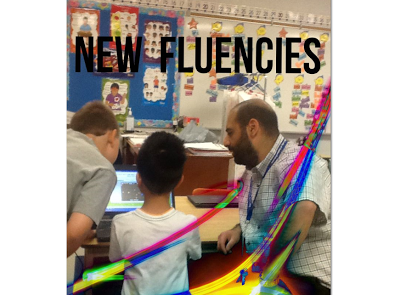Today I had the opportunity to visit Rolland’s class while his Grade Two students were creating stories using the Toontastic app on their iPads. What I observed was truly remarkable. Their assignment had been to create stories around an issue they had encountered at First Holy Communion time as the central focus of the story. The “problem” had to be set within the context of a story with a plot having characters, a setting, a problem, the solution, and their favourite part -- cartooning with digital images they were able to edit and manipulate. Rolland had prepared the students by engaging them in the creation of Success Criteria connected to the Learning Goal, and the students had brainstormed a series of anchor charts breaking down the various pieces they needed to work on in order to assemble a final successful cartoon story.
The process itself versus the product is what I want to comment on. The products – which are in themselves delightful small digital vignettes that tell a story from beginning to end using cartooning, students voices as characters recorded as voice overs and background classical mood music applied by the students to the five scenes of the story, though remarkable in themselves, represent only about one tenth of the total work the students engaged in. What I mean to say is, what you see cartooned, is only a fraction of what happened behind the scenes to produce wonderful little pieces of work.
Behind the scenes I watched one group of four students engaged for 25 minutes in deep sustained higher order thinking at a level one would assume barely possible for this age group without coaching and supervision. Independently they were asking each other very meaningful and challenging questions and the tasks they were setting for themselves were amazing. Students were using language such as: “that dialogue doesn’t belong here because we need to keep that for the climax of the story.” And “that character wouldn’t speak that way, that tone belongs to this character.” Another time when a Grade Two boy recorded his dialogue too slowly, a female classmate said to him: "that was really good X, do you want to do it again but this time do the same thing but a little faster.” His response was: “that’s what my mother always says about my reading, “pick up the pace X.” Okay let’s do it again.”
The activity invited collaboration, co-operation, planning, sustained engagement, and creativity. It is the dynamic between the students that amazed me. They took their task seriously and were able to practice shared decision making and problem solving at a very high level. The dynamic between them as they huddled over the technology, using an app that invites this form of sharing, would be no different than the dynamic with a group of graduate student researchers huddled over their latest equipment looking for a solution to a problem. Perhaps even smoother as their egos are small, versus the egos of several PhD scholars vying for the next research grant. What fun to witness students working collaboratively at a higher order thinking activity in such a delightful fashion.
Mark Godin is Principal at Our Lady of Fatima Catholic elementary school in Cambridge, Ontario and can be reached at – Mark.Godin@wcdsb.ca

Kudos to OLOF principal Mark Godin for his solid support of teacher Rolland Chidiac's inspiring integration of educational technology in the primary classroom. The authentic collaboration among Rolland's young students around their '1st Holy Communion Toontastic' project speaks volumes.
ReplyDelete